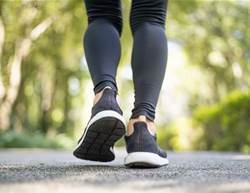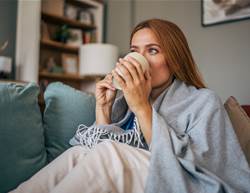Imagine being in constant pain so severe that it takes over your thoughts and affects your ability to function. That was presenter Osher Günsberg's experience when he was diagnosed with degenerative joint disease osteoarthritis and had to have hip replacement surgery, which led to complications.
“I would walk around with a look on my face which said ‘what did you just say?’ This would change my interactions with my wife and family quite negatively,” he says.
And this experience is more common than we realise; according to the 2023 National Pain Survey, 3.6 million Australians "are struggling with the impacts of daily pain". This impacts their mental health and ability to sleep, work and exercise.
Günsberg has talked about his physical health challenges on his podcast Better Than Yesterday, as well as how they have impacted his mental health. His own experience of pain means Günsberg brings an emotive and personal interest to the new documentary Osher Günsberg: A World of Pain, now available on SBS On Demand. In it, he meets people and families impacted by pain, and investigates what surprising new science, medications and alternative therapies are being used to treat and manage it.
We spoke with Günsberg about his own experience of pain and what he learned filming the new documentary.
What has helped you get through the mental health impacts of chronic pain?
OG: I can only be grateful that everything happened to me in order. When I got diagnosed with PTSD, I learned cognitive behavioural therapy. The idea that “just because I think it, doesn't make it real” was new to me then. This really helped when it came time to get sober as I was able to attend to the thoughts and notice them going by.
When I got really sick later on, I needed to do exposure therapy to find my way out of that anxiety quagmire. Being willing to be with the discomfort, uncomfortable thoughts and feelings was what eventually freed me from them.
So having all of these experiences already, knowing that they work – when my pain psychologist asked me to focus on this agonising sensation and really attend to it, I knew that even though it was incredibly uncomfortable to do so, in the same way as before it would diminish the power the sensation had over me and allow me to make space around it into which I could put things like joy, smiling, and laughing with my family.
You’ve experienced debilitating pain before and after surgery – what’s helped you physically?
OG: It can't be underestimated that strength and mobility are the greatest line of defence against pain.
As long as you've checked in with your physio or exercise physiologist, moving through a range of motion under load, even if it is painful to do so, goes a long way to giving your body a signal that it is safe to move in that range of motion.
At first, it's quite difficult because you’re trying to hotwire your body’s self-protection mode. All the signals you're getting sent are screaming at you to stop. Yet in my experience, being willing to be with discomfort of moving through those ranges of motion under load is the thing which sends a signal to the soft tissue that you're actually okay, and you needn’t be afraid of moving in this way.

What have you learned filming this doco?
OG: I really wanted to share with people that there are incredibly dedicated, super-smart people working day and night to try to provide solutions and a better quality of life for people who are experiencing pain.
We are not at a dead end as far as treatments go, and we are not out of ideas. Being able to show that there is possibility goes a long way to giving hope to someone feeling these things.
On a personal note, I was very excited to learn about the [natural] “opioid overshoot”. Deliberately exposing yourself to discomfort and then experiencing something which is pleasurable is amplified immeasurably.
We replicated this by using an ice bath and a chocolate biscuit, however it was wonderful to know that these incredible sensations were being produced by my own body and I needed to not take any drug or anything like that in order to feel such a sensation.
Are there any new developments or therapies that surprised you?
OG: The research we uncovered in Adelaide [on visualising pain] – if they can thread the needle and miniaturise the technology, that will absolutely change the world. The ability to actually visualise pain in a patient will give not only clinicians but also sufferers a pathway to understand if they are indeed getting better. That will be transformative if they can figure out how to get it small enough to sit on a GPs desk.










